The common law of the United Kingdom
VerifiedAdded on 2022/08/16
|11
|3036
|17
AI Summary
Contribute Materials
Your contribution can guide someone’s learning journey. Share your
documents today.
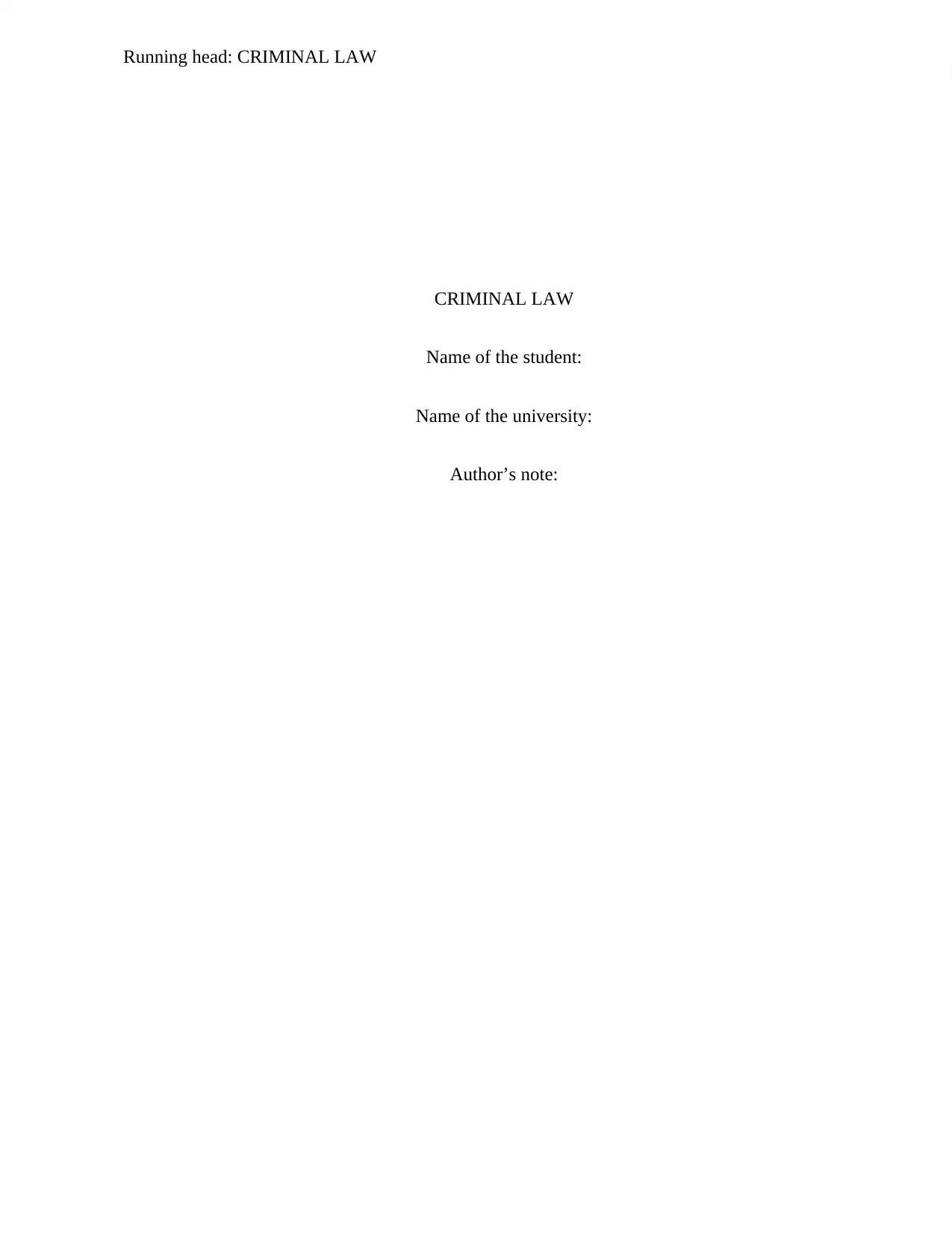
Running head: CRIMINAL LAW
0
CRIMINAL LAW
Name of the student:
Name of the university:
Author’s note:
0
CRIMINAL LAW
Name of the student:
Name of the university:
Author’s note:
Secure Best Marks with AI Grader
Need help grading? Try our AI Grader for instant feedback on your assignments.
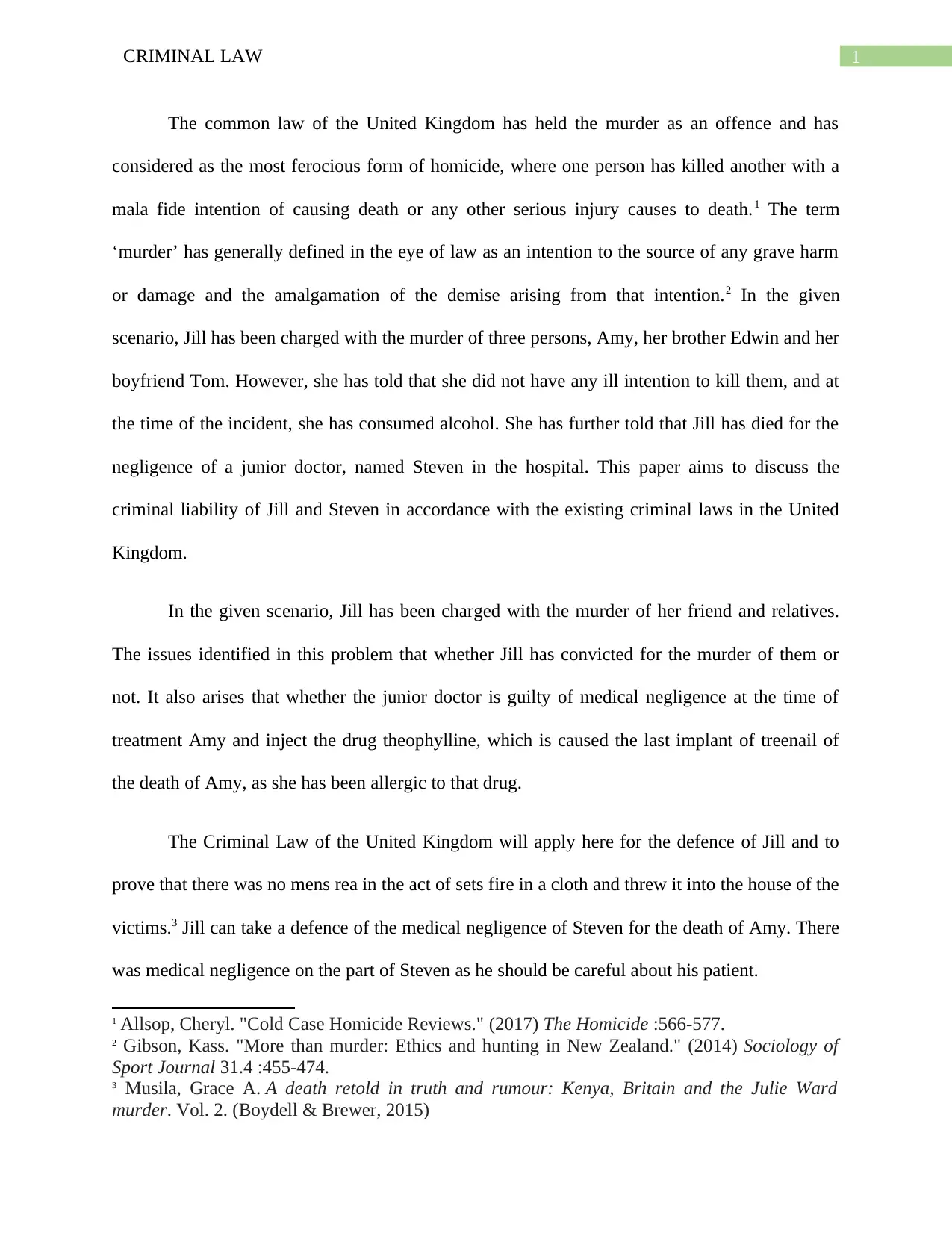
1CRIMINAL LAW
The common law of the United Kingdom has held the murder as an offence and has
considered as the most ferocious form of homicide, where one person has killed another with a
mala fide intention of causing death or any other serious injury causes to death.1 The term
‘murder’ has generally defined in the eye of law as an intention to the source of any grave harm
or damage and the amalgamation of the demise arising from that intention.2 In the given
scenario, Jill has been charged with the murder of three persons, Amy, her brother Edwin and her
boyfriend Tom. However, she has told that she did not have any ill intention to kill them, and at
the time of the incident, she has consumed alcohol. She has further told that Jill has died for the
negligence of a junior doctor, named Steven in the hospital. This paper aims to discuss the
criminal liability of Jill and Steven in accordance with the existing criminal laws in the United
Kingdom.
In the given scenario, Jill has been charged with the murder of her friend and relatives.
The issues identified in this problem that whether Jill has convicted for the murder of them or
not. It also arises that whether the junior doctor is guilty of medical negligence at the time of
treatment Amy and inject the drug theophylline, which is caused the last implant of treenail of
the death of Amy, as she has been allergic to that drug.
The Criminal Law of the United Kingdom will apply here for the defence of Jill and to
prove that there was no mens rea in the act of sets fire in a cloth and threw it into the house of the
victims.3 Jill can take a defence of the medical negligence of Steven for the death of Amy. There
was medical negligence on the part of Steven as he should be careful about his patient.
1 Allsop, Cheryl. "Cold Case Homicide Reviews." (2017) The Homicide :566-577.
2 Gibson, Kass. "More than murder: Ethics and hunting in New Zealand." (2014) Sociology of
Sport Journal 31.4 :455-474.
3 Musila, Grace A. A death retold in truth and rumour: Kenya, Britain and the Julie Ward
murder. Vol. 2. (Boydell & Brewer, 2015)
The common law of the United Kingdom has held the murder as an offence and has
considered as the most ferocious form of homicide, where one person has killed another with a
mala fide intention of causing death or any other serious injury causes to death.1 The term
‘murder’ has generally defined in the eye of law as an intention to the source of any grave harm
or damage and the amalgamation of the demise arising from that intention.2 In the given
scenario, Jill has been charged with the murder of three persons, Amy, her brother Edwin and her
boyfriend Tom. However, she has told that she did not have any ill intention to kill them, and at
the time of the incident, she has consumed alcohol. She has further told that Jill has died for the
negligence of a junior doctor, named Steven in the hospital. This paper aims to discuss the
criminal liability of Jill and Steven in accordance with the existing criminal laws in the United
Kingdom.
In the given scenario, Jill has been charged with the murder of her friend and relatives.
The issues identified in this problem that whether Jill has convicted for the murder of them or
not. It also arises that whether the junior doctor is guilty of medical negligence at the time of
treatment Amy and inject the drug theophylline, which is caused the last implant of treenail of
the death of Amy, as she has been allergic to that drug.
The Criminal Law of the United Kingdom will apply here for the defence of Jill and to
prove that there was no mens rea in the act of sets fire in a cloth and threw it into the house of the
victims.3 Jill can take a defence of the medical negligence of Steven for the death of Amy. There
was medical negligence on the part of Steven as he should be careful about his patient.
1 Allsop, Cheryl. "Cold Case Homicide Reviews." (2017) The Homicide :566-577.
2 Gibson, Kass. "More than murder: Ethics and hunting in New Zealand." (2014) Sociology of
Sport Journal 31.4 :455-474.
3 Musila, Grace A. A death retold in truth and rumour: Kenya, Britain and the Julie Ward
murder. Vol. 2. (Boydell & Brewer, 2015)
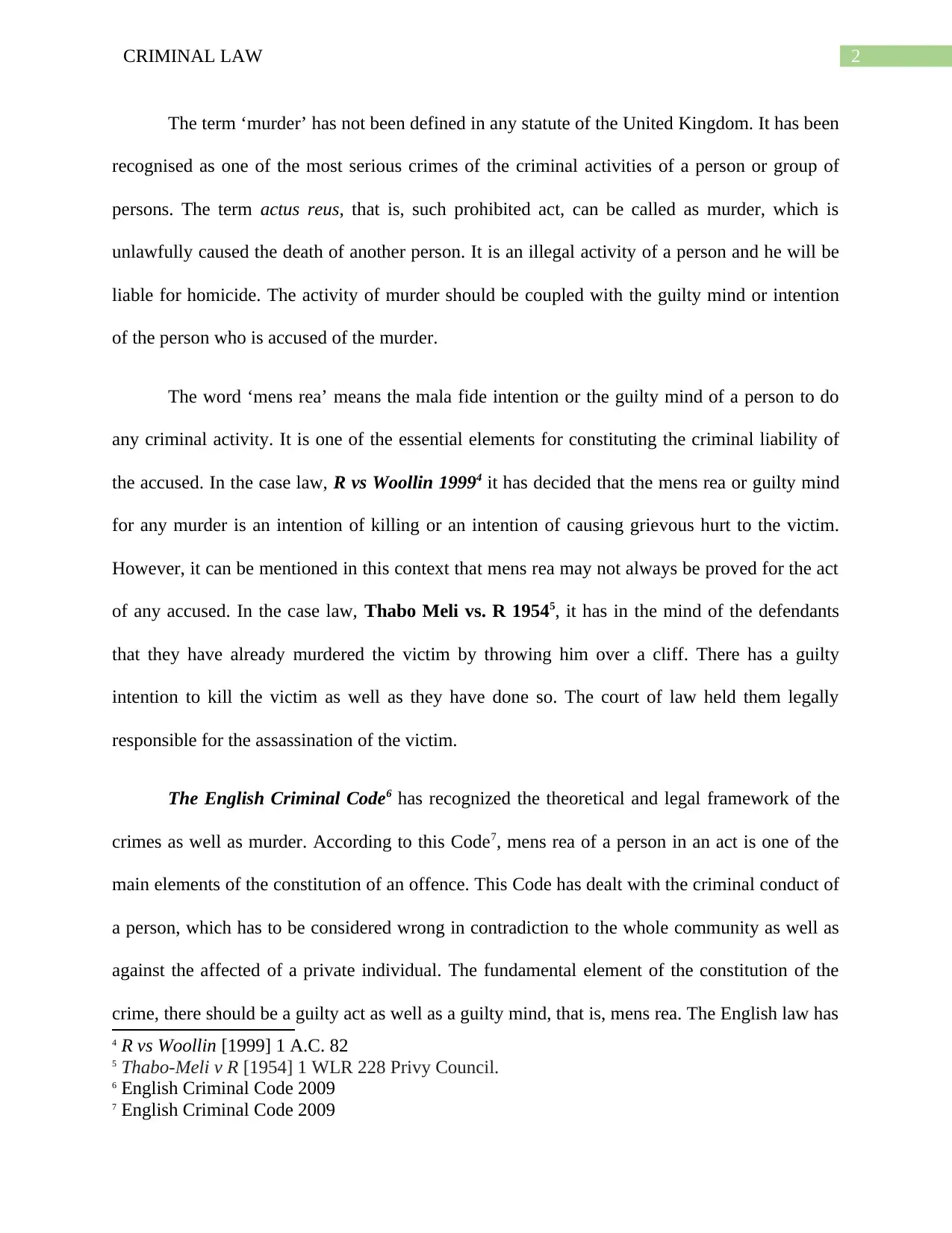
2CRIMINAL LAW
The term ‘murder’ has not been defined in any statute of the United Kingdom. It has been
recognised as one of the most serious crimes of the criminal activities of a person or group of
persons. The term actus reus, that is, such prohibited act, can be called as murder, which is
unlawfully caused the death of another person. It is an illegal activity of a person and he will be
liable for homicide. The activity of murder should be coupled with the guilty mind or intention
of the person who is accused of the murder.
The word ‘mens rea’ means the mala fide intention or the guilty mind of a person to do
any criminal activity. It is one of the essential elements for constituting the criminal liability of
the accused. In the case law, R vs Woollin 19994 it has decided that the mens rea or guilty mind
for any murder is an intention of killing or an intention of causing grievous hurt to the victim.
However, it can be mentioned in this context that mens rea may not always be proved for the act
of any accused. In the case law, Thabo Meli vs. R 19545, it has in the mind of the defendants
that they have already murdered the victim by throwing him over a cliff. There has a guilty
intention to kill the victim as well as they have done so. The court of law held them legally
responsible for the assassination of the victim.
The English Criminal Code6 has recognized the theoretical and legal framework of the
crimes as well as murder. According to this Code7, mens rea of a person in an act is one of the
main elements of the constitution of an offence. This Code has dealt with the criminal conduct of
a person, which has to be considered wrong in contradiction to the whole community as well as
against the affected of a private individual. The fundamental element of the constitution of the
crime, there should be a guilty act as well as a guilty mind, that is, mens rea. The English law has
4 R vs Woollin [1999] 1 A.C. 82
5 Thabo-Meli v R [1954] 1 WLR 228 Privy Council.
6 English Criminal Code 2009
7 English Criminal Code 2009
The term ‘murder’ has not been defined in any statute of the United Kingdom. It has been
recognised as one of the most serious crimes of the criminal activities of a person or group of
persons. The term actus reus, that is, such prohibited act, can be called as murder, which is
unlawfully caused the death of another person. It is an illegal activity of a person and he will be
liable for homicide. The activity of murder should be coupled with the guilty mind or intention
of the person who is accused of the murder.
The word ‘mens rea’ means the mala fide intention or the guilty mind of a person to do
any criminal activity. It is one of the essential elements for constituting the criminal liability of
the accused. In the case law, R vs Woollin 19994 it has decided that the mens rea or guilty mind
for any murder is an intention of killing or an intention of causing grievous hurt to the victim.
However, it can be mentioned in this context that mens rea may not always be proved for the act
of any accused. In the case law, Thabo Meli vs. R 19545, it has in the mind of the defendants
that they have already murdered the victim by throwing him over a cliff. There has a guilty
intention to kill the victim as well as they have done so. The court of law held them legally
responsible for the assassination of the victim.
The English Criminal Code6 has recognized the theoretical and legal framework of the
crimes as well as murder. According to this Code7, mens rea of a person in an act is one of the
main elements of the constitution of an offence. This Code has dealt with the criminal conduct of
a person, which has to be considered wrong in contradiction to the whole community as well as
against the affected of a private individual. The fundamental element of the constitution of the
crime, there should be a guilty act as well as a guilty mind, that is, mens rea. The English law has
4 R vs Woollin [1999] 1 A.C. 82
5 Thabo-Meli v R [1954] 1 WLR 228 Privy Council.
6 English Criminal Code 2009
7 English Criminal Code 2009
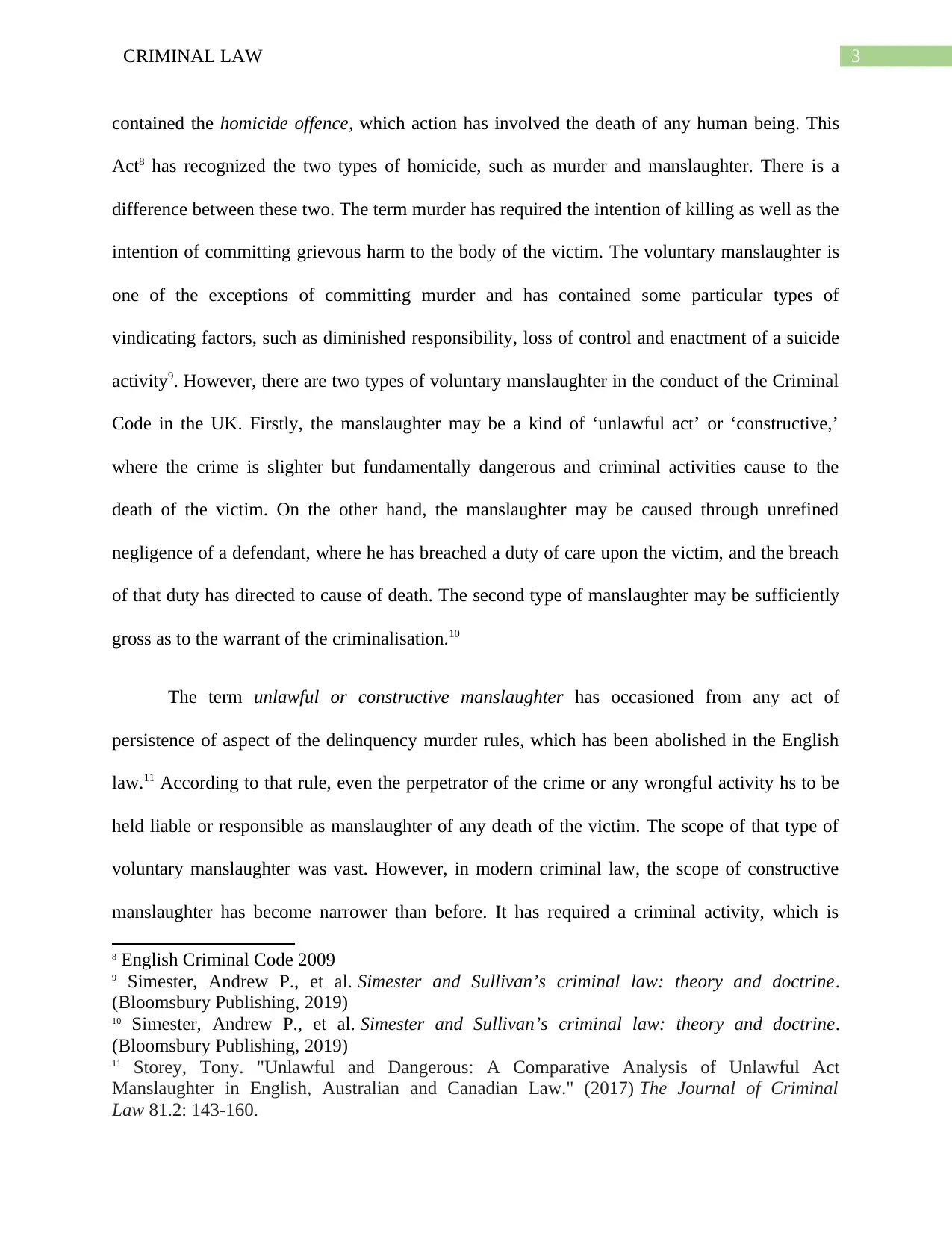
3CRIMINAL LAW
contained the homicide offence, which action has involved the death of any human being. This
Act8 has recognized the two types of homicide, such as murder and manslaughter. There is a
difference between these two. The term murder has required the intention of killing as well as the
intention of committing grievous harm to the body of the victim. The voluntary manslaughter is
one of the exceptions of committing murder and has contained some particular types of
vindicating factors, such as diminished responsibility, loss of control and enactment of a suicide
activity9. However, there are two types of voluntary manslaughter in the conduct of the Criminal
Code in the UK. Firstly, the manslaughter may be a kind of ‘unlawful act’ or ‘constructive,’
where the crime is slighter but fundamentally dangerous and criminal activities cause to the
death of the victim. On the other hand, the manslaughter may be caused through unrefined
negligence of a defendant, where he has breached a duty of care upon the victim, and the breach
of that duty has directed to cause of death. The second type of manslaughter may be sufficiently
gross as to the warrant of the criminalisation.10
The term unlawful or constructive manslaughter has occasioned from any act of
persistence of aspect of the delinquency murder rules, which has been abolished in the English
law.11 According to that rule, even the perpetrator of the crime or any wrongful activity hs to be
held liable or responsible as manslaughter of any death of the victim. The scope of that type of
voluntary manslaughter was vast. However, in modern criminal law, the scope of constructive
manslaughter has become narrower than before. It has required a criminal activity, which is
8 English Criminal Code 2009
9 Simester, Andrew P., et al. Simester and Sullivan’s criminal law: theory and doctrine.
(Bloomsbury Publishing, 2019)
10 Simester, Andrew P., et al. Simester and Sullivan’s criminal law: theory and doctrine.
(Bloomsbury Publishing, 2019)
11 Storey, Tony. "Unlawful and Dangerous: A Comparative Analysis of Unlawful Act
Manslaughter in English, Australian and Canadian Law." (2017) The Journal of Criminal
Law 81.2: 143-160.
contained the homicide offence, which action has involved the death of any human being. This
Act8 has recognized the two types of homicide, such as murder and manslaughter. There is a
difference between these two. The term murder has required the intention of killing as well as the
intention of committing grievous harm to the body of the victim. The voluntary manslaughter is
one of the exceptions of committing murder and has contained some particular types of
vindicating factors, such as diminished responsibility, loss of control and enactment of a suicide
activity9. However, there are two types of voluntary manslaughter in the conduct of the Criminal
Code in the UK. Firstly, the manslaughter may be a kind of ‘unlawful act’ or ‘constructive,’
where the crime is slighter but fundamentally dangerous and criminal activities cause to the
death of the victim. On the other hand, the manslaughter may be caused through unrefined
negligence of a defendant, where he has breached a duty of care upon the victim, and the breach
of that duty has directed to cause of death. The second type of manslaughter may be sufficiently
gross as to the warrant of the criminalisation.10
The term unlawful or constructive manslaughter has occasioned from any act of
persistence of aspect of the delinquency murder rules, which has been abolished in the English
law.11 According to that rule, even the perpetrator of the crime or any wrongful activity hs to be
held liable or responsible as manslaughter of any death of the victim. The scope of that type of
voluntary manslaughter was vast. However, in modern criminal law, the scope of constructive
manslaughter has become narrower than before. It has required a criminal activity, which is
8 English Criminal Code 2009
9 Simester, Andrew P., et al. Simester and Sullivan’s criminal law: theory and doctrine.
(Bloomsbury Publishing, 2019)
10 Simester, Andrew P., et al. Simester and Sullivan’s criminal law: theory and doctrine.
(Bloomsbury Publishing, 2019)
11 Storey, Tony. "Unlawful and Dangerous: A Comparative Analysis of Unlawful Act
Manslaughter in English, Australian and Canadian Law." (2017) The Journal of Criminal
Law 81.2: 143-160.
Secure Best Marks with AI Grader
Need help grading? Try our AI Grader for instant feedback on your assignments.
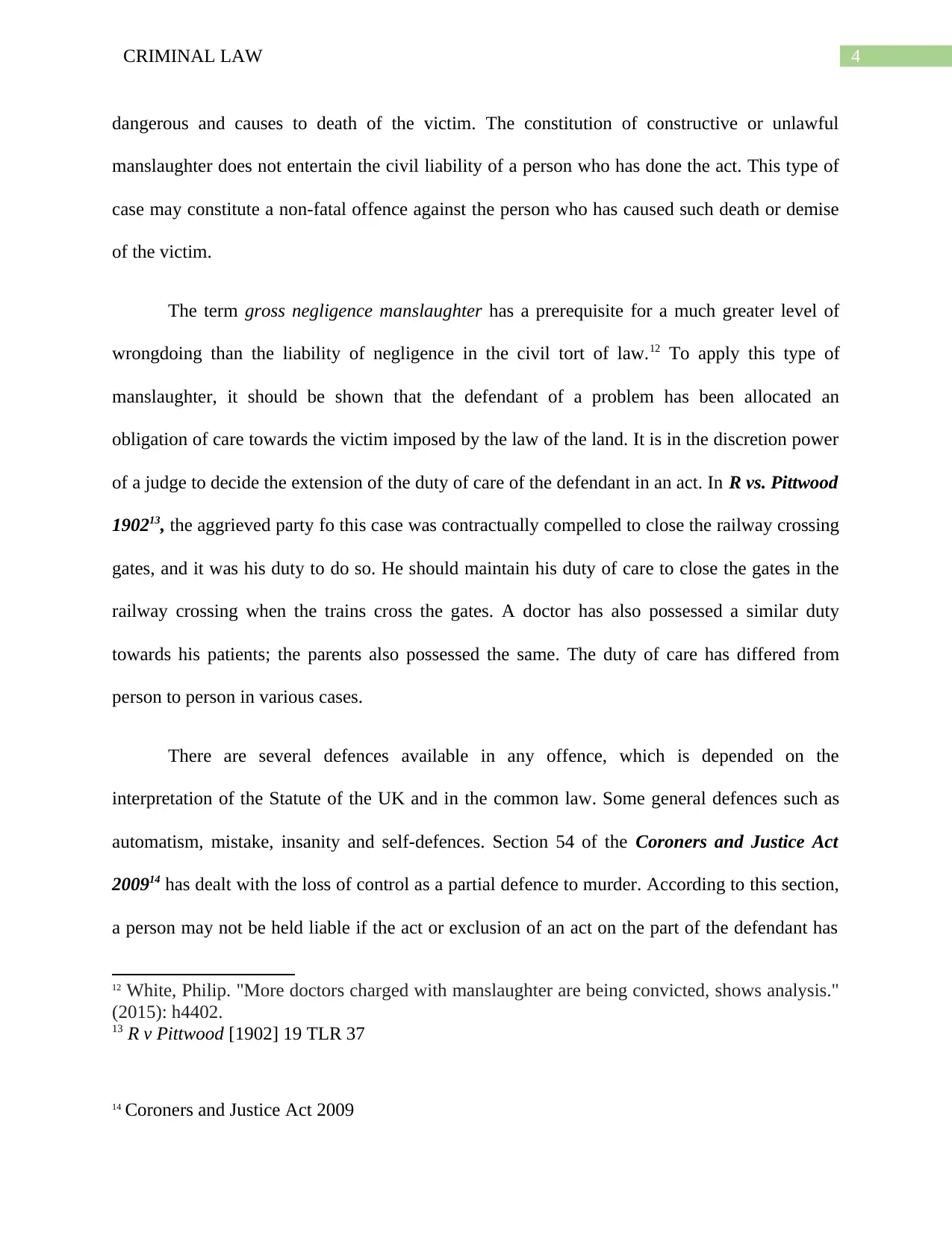
4CRIMINAL LAW
dangerous and causes to death of the victim. The constitution of constructive or unlawful
manslaughter does not entertain the civil liability of a person who has done the act. This type of
case may constitute a non-fatal offence against the person who has caused such death or demise
of the victim.
The term gross negligence manslaughter has a prerequisite for a much greater level of
wrongdoing than the liability of negligence in the civil tort of law.12 To apply this type of
manslaughter, it should be shown that the defendant of a problem has been allocated an
obligation of care towards the victim imposed by the law of the land. It is in the discretion power
of a judge to decide the extension of the duty of care of the defendant in an act. In R vs. Pittwood
190213, the aggrieved party fo this case was contractually compelled to close the railway crossing
gates, and it was his duty to do so. He should maintain his duty of care to close the gates in the
railway crossing when the trains cross the gates. A doctor has also possessed a similar duty
towards his patients; the parents also possessed the same. The duty of care has differed from
person to person in various cases.
There are several defences available in any offence, which is depended on the
interpretation of the Statute of the UK and in the common law. Some general defences such as
automatism, mistake, insanity and self-defences. Section 54 of the Coroners and Justice Act
200914 has dealt with the loss of control as a partial defence to murder. According to this section,
a person may not be held liable if the act or exclusion of an act on the part of the defendant has
12 White, Philip. "More doctors charged with manslaughter are being convicted, shows analysis."
(2015): h4402.
13 R v Pittwood [1902] 19 TLR 37
14 Coroners and Justice Act 2009
dangerous and causes to death of the victim. The constitution of constructive or unlawful
manslaughter does not entertain the civil liability of a person who has done the act. This type of
case may constitute a non-fatal offence against the person who has caused such death or demise
of the victim.
The term gross negligence manslaughter has a prerequisite for a much greater level of
wrongdoing than the liability of negligence in the civil tort of law.12 To apply this type of
manslaughter, it should be shown that the defendant of a problem has been allocated an
obligation of care towards the victim imposed by the law of the land. It is in the discretion power
of a judge to decide the extension of the duty of care of the defendant in an act. In R vs. Pittwood
190213, the aggrieved party fo this case was contractually compelled to close the railway crossing
gates, and it was his duty to do so. He should maintain his duty of care to close the gates in the
railway crossing when the trains cross the gates. A doctor has also possessed a similar duty
towards his patients; the parents also possessed the same. The duty of care has differed from
person to person in various cases.
There are several defences available in any offence, which is depended on the
interpretation of the Statute of the UK and in the common law. Some general defences such as
automatism, mistake, insanity and self-defences. Section 54 of the Coroners and Justice Act
200914 has dealt with the loss of control as a partial defence to murder. According to this section,
a person may not be held liable if the act or exclusion of an act on the part of the defendant has
12 White, Philip. "More doctors charged with manslaughter are being convicted, shows analysis."
(2015): h4402.
13 R v Pittwood [1902] 19 TLR 37
14 Coroners and Justice Act 2009
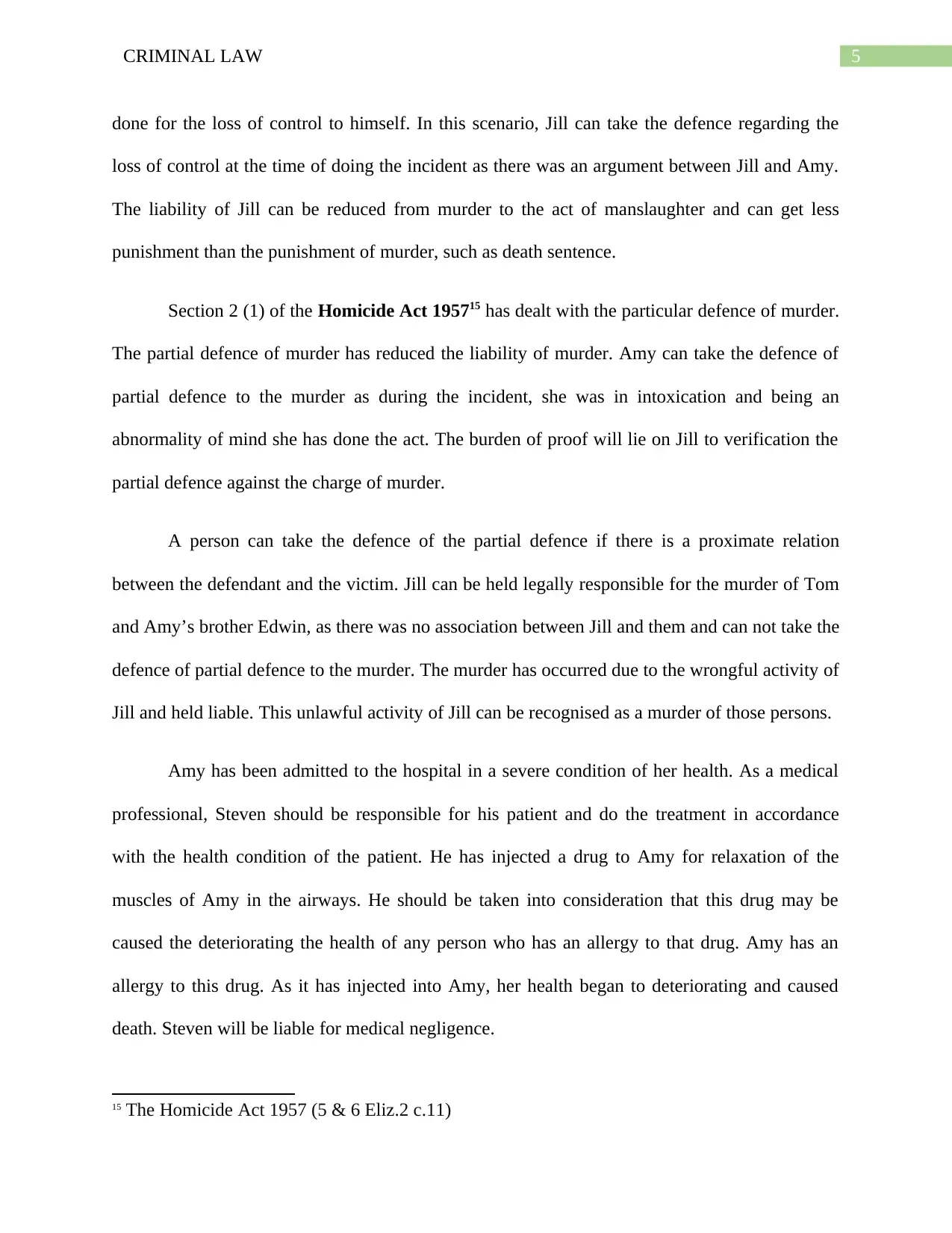
5CRIMINAL LAW
done for the loss of control to himself. In this scenario, Jill can take the defence regarding the
loss of control at the time of doing the incident as there was an argument between Jill and Amy.
The liability of Jill can be reduced from murder to the act of manslaughter and can get less
punishment than the punishment of murder, such as death sentence.
Section 2 (1) of the Homicide Act 195715 has dealt with the particular defence of murder.
The partial defence of murder has reduced the liability of murder. Amy can take the defence of
partial defence to the murder as during the incident, she was in intoxication and being an
abnormality of mind she has done the act. The burden of proof will lie on Jill to verification the
partial defence against the charge of murder.
A person can take the defence of the partial defence if there is a proximate relation
between the defendant and the victim. Jill can be held legally responsible for the murder of Tom
and Amy’s brother Edwin, as there was no association between Jill and them and can not take the
defence of partial defence to the murder. The murder has occurred due to the wrongful activity of
Jill and held liable. This unlawful activity of Jill can be recognised as a murder of those persons.
Amy has been admitted to the hospital in a severe condition of her health. As a medical
professional, Steven should be responsible for his patient and do the treatment in accordance
with the health condition of the patient. He has injected a drug to Amy for relaxation of the
muscles of Amy in the airways. He should be taken into consideration that this drug may be
caused the deteriorating the health of any person who has an allergy to that drug. Amy has an
allergy to this drug. As it has injected into Amy, her health began to deteriorating and caused
death. Steven will be liable for medical negligence.
15 The Homicide Act 1957 (5 & 6 Eliz.2 c.11)
done for the loss of control to himself. In this scenario, Jill can take the defence regarding the
loss of control at the time of doing the incident as there was an argument between Jill and Amy.
The liability of Jill can be reduced from murder to the act of manslaughter and can get less
punishment than the punishment of murder, such as death sentence.
Section 2 (1) of the Homicide Act 195715 has dealt with the particular defence of murder.
The partial defence of murder has reduced the liability of murder. Amy can take the defence of
partial defence to the murder as during the incident, she was in intoxication and being an
abnormality of mind she has done the act. The burden of proof will lie on Jill to verification the
partial defence against the charge of murder.
A person can take the defence of the partial defence if there is a proximate relation
between the defendant and the victim. Jill can be held legally responsible for the murder of Tom
and Amy’s brother Edwin, as there was no association between Jill and them and can not take the
defence of partial defence to the murder. The murder has occurred due to the wrongful activity of
Jill and held liable. This unlawful activity of Jill can be recognised as a murder of those persons.
Amy has been admitted to the hospital in a severe condition of her health. As a medical
professional, Steven should be responsible for his patient and do the treatment in accordance
with the health condition of the patient. He has injected a drug to Amy for relaxation of the
muscles of Amy in the airways. He should be taken into consideration that this drug may be
caused the deteriorating the health of any person who has an allergy to that drug. Amy has an
allergy to this drug. As it has injected into Amy, her health began to deteriorating and caused
death. Steven will be liable for medical negligence.
15 The Homicide Act 1957 (5 & 6 Eliz.2 c.11)
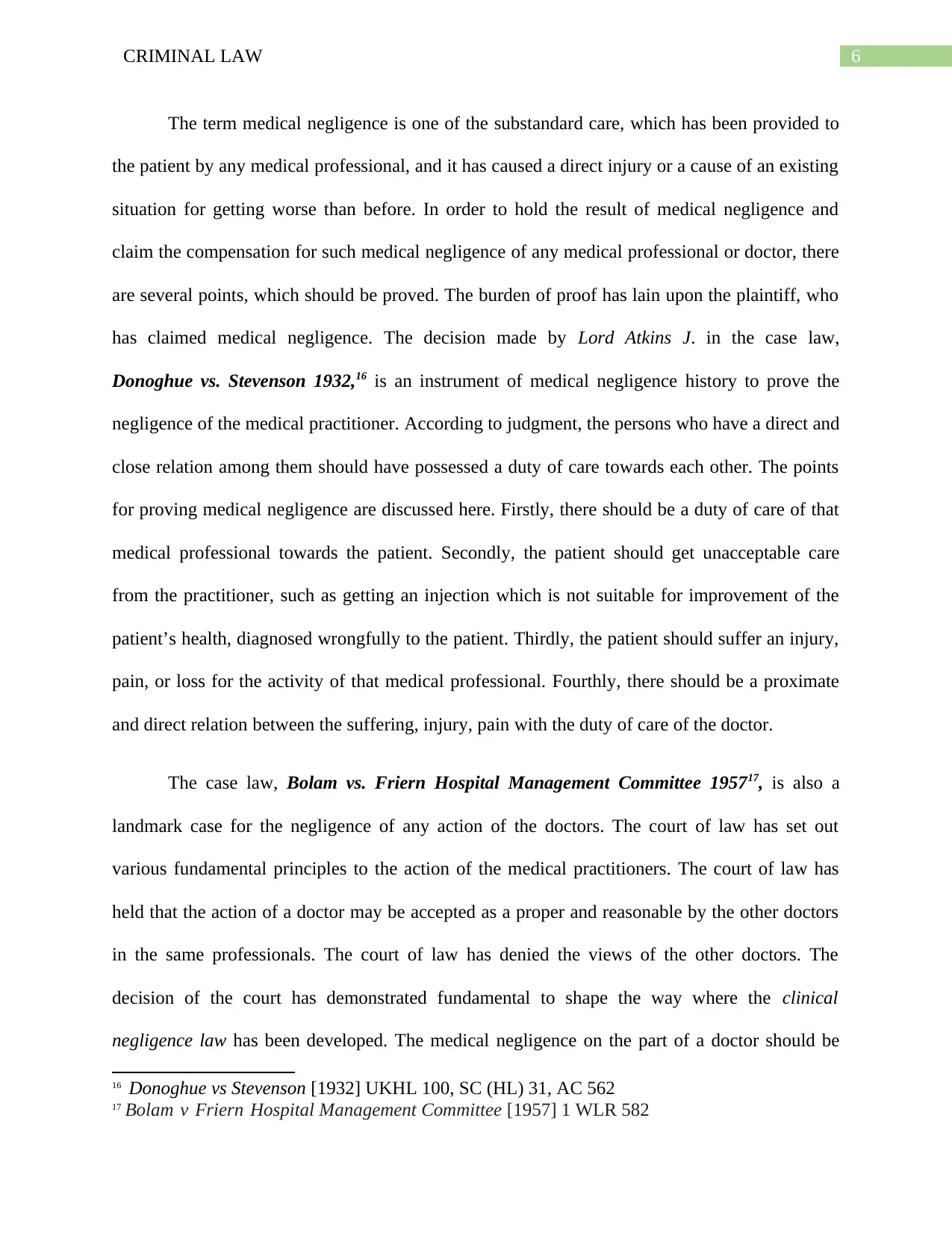
6CRIMINAL LAW
The term medical negligence is one of the substandard care, which has been provided to
the patient by any medical professional, and it has caused a direct injury or a cause of an existing
situation for getting worse than before. In order to hold the result of medical negligence and
claim the compensation for such medical negligence of any medical professional or doctor, there
are several points, which should be proved. The burden of proof has lain upon the plaintiff, who
has claimed medical negligence. The decision made by Lord Atkins J. in the case law,
Donoghue vs. Stevenson 1932,16 is an instrument of medical negligence history to prove the
negligence of the medical practitioner. According to judgment, the persons who have a direct and
close relation among them should have possessed a duty of care towards each other. The points
for proving medical negligence are discussed here. Firstly, there should be a duty of care of that
medical professional towards the patient. Secondly, the patient should get unacceptable care
from the practitioner, such as getting an injection which is not suitable for improvement of the
patient’s health, diagnosed wrongfully to the patient. Thirdly, the patient should suffer an injury,
pain, or loss for the activity of that medical professional. Fourthly, there should be a proximate
and direct relation between the suffering, injury, pain with the duty of care of the doctor.
The case law, Bolam vs. Friern Hospital Management Committee 195717, is also a
landmark case for the negligence of any action of the doctors. The court of law has set out
various fundamental principles to the action of the medical practitioners. The court of law has
held that the action of a doctor may be accepted as a proper and reasonable by the other doctors
in the same professionals. The court of law has denied the views of the other doctors. The
decision of the court has demonstrated fundamental to shape the way where the clinical
negligence law has been developed. The medical negligence on the part of a doctor should be
16 Donoghue vs Stevenson [1932] UKHL 100, SC (HL) 31, AC 562
17 Bolam v Friern Hospital Management Committee [1957] 1 WLR 582
The term medical negligence is one of the substandard care, which has been provided to
the patient by any medical professional, and it has caused a direct injury or a cause of an existing
situation for getting worse than before. In order to hold the result of medical negligence and
claim the compensation for such medical negligence of any medical professional or doctor, there
are several points, which should be proved. The burden of proof has lain upon the plaintiff, who
has claimed medical negligence. The decision made by Lord Atkins J. in the case law,
Donoghue vs. Stevenson 1932,16 is an instrument of medical negligence history to prove the
negligence of the medical practitioner. According to judgment, the persons who have a direct and
close relation among them should have possessed a duty of care towards each other. The points
for proving medical negligence are discussed here. Firstly, there should be a duty of care of that
medical professional towards the patient. Secondly, the patient should get unacceptable care
from the practitioner, such as getting an injection which is not suitable for improvement of the
patient’s health, diagnosed wrongfully to the patient. Thirdly, the patient should suffer an injury,
pain, or loss for the activity of that medical professional. Fourthly, there should be a proximate
and direct relation between the suffering, injury, pain with the duty of care of the doctor.
The case law, Bolam vs. Friern Hospital Management Committee 195717, is also a
landmark case for the negligence of any action of the doctors. The court of law has set out
various fundamental principles to the action of the medical practitioners. The court of law has
held that the action of a doctor may be accepted as a proper and reasonable by the other doctors
in the same professionals. The court of law has denied the views of the other doctors. The
decision of the court has demonstrated fundamental to shape the way where the clinical
negligence law has been developed. The medical negligence on the part of a doctor should be
16 Donoghue vs Stevenson [1932] UKHL 100, SC (HL) 31, AC 562
17 Bolam v Friern Hospital Management Committee [1957] 1 WLR 582
Paraphrase This Document
Need a fresh take? Get an instant paraphrase of this document with our AI Paraphraser
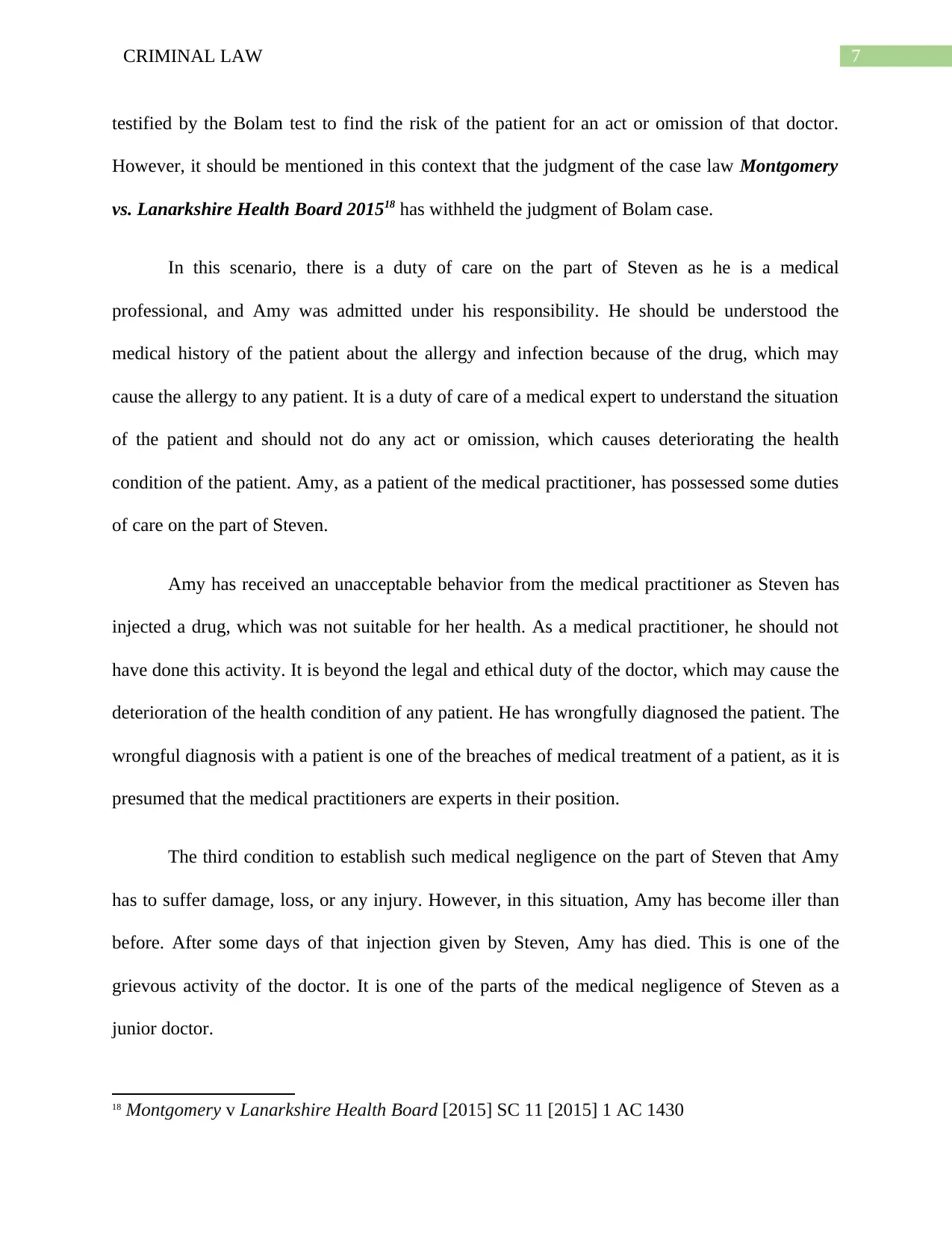
7CRIMINAL LAW
testified by the Bolam test to find the risk of the patient for an act or omission of that doctor.
However, it should be mentioned in this context that the judgment of the case law Montgomery
vs. Lanarkshire Health Board 201518 has withheld the judgment of Bolam case.
In this scenario, there is a duty of care on the part of Steven as he is a medical
professional, and Amy was admitted under his responsibility. He should be understood the
medical history of the patient about the allergy and infection because of the drug, which may
cause the allergy to any patient. It is a duty of care of a medical expert to understand the situation
of the patient and should not do any act or omission, which causes deteriorating the health
condition of the patient. Amy, as a patient of the medical practitioner, has possessed some duties
of care on the part of Steven.
Amy has received an unacceptable behavior from the medical practitioner as Steven has
injected a drug, which was not suitable for her health. As a medical practitioner, he should not
have done this activity. It is beyond the legal and ethical duty of the doctor, which may cause the
deterioration of the health condition of any patient. He has wrongfully diagnosed the patient. The
wrongful diagnosis with a patient is one of the breaches of medical treatment of a patient, as it is
presumed that the medical practitioners are experts in their position.
The third condition to establish such medical negligence on the part of Steven that Amy
has to suffer damage, loss, or any injury. However, in this situation, Amy has become iller than
before. After some days of that injection given by Steven, Amy has died. This is one of the
grievous activity of the doctor. It is one of the parts of the medical negligence of Steven as a
junior doctor.
18 Montgomery v Lanarkshire Health Board [2015] SC 11 [2015] 1 AC 1430
testified by the Bolam test to find the risk of the patient for an act or omission of that doctor.
However, it should be mentioned in this context that the judgment of the case law Montgomery
vs. Lanarkshire Health Board 201518 has withheld the judgment of Bolam case.
In this scenario, there is a duty of care on the part of Steven as he is a medical
professional, and Amy was admitted under his responsibility. He should be understood the
medical history of the patient about the allergy and infection because of the drug, which may
cause the allergy to any patient. It is a duty of care of a medical expert to understand the situation
of the patient and should not do any act or omission, which causes deteriorating the health
condition of the patient. Amy, as a patient of the medical practitioner, has possessed some duties
of care on the part of Steven.
Amy has received an unacceptable behavior from the medical practitioner as Steven has
injected a drug, which was not suitable for her health. As a medical practitioner, he should not
have done this activity. It is beyond the legal and ethical duty of the doctor, which may cause the
deterioration of the health condition of any patient. He has wrongfully diagnosed the patient. The
wrongful diagnosis with a patient is one of the breaches of medical treatment of a patient, as it is
presumed that the medical practitioners are experts in their position.
The third condition to establish such medical negligence on the part of Steven that Amy
has to suffer damage, loss, or any injury. However, in this situation, Amy has become iller than
before. After some days of that injection given by Steven, Amy has died. This is one of the
grievous activity of the doctor. It is one of the parts of the medical negligence of Steven as a
junior doctor.
18 Montgomery v Lanarkshire Health Board [2015] SC 11 [2015] 1 AC 1430
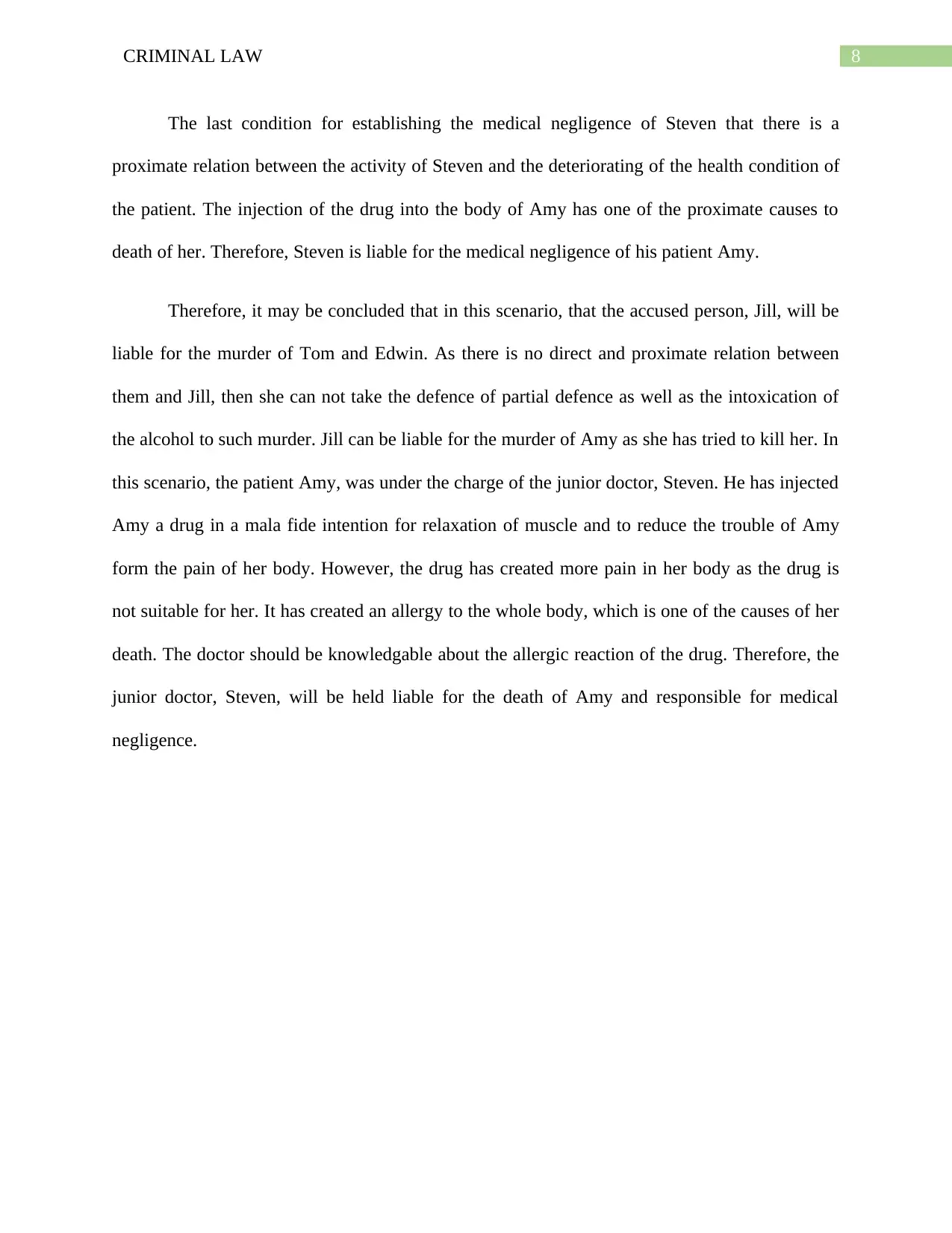
8CRIMINAL LAW
The last condition for establishing the medical negligence of Steven that there is a
proximate relation between the activity of Steven and the deteriorating of the health condition of
the patient. The injection of the drug into the body of Amy has one of the proximate causes to
death of her. Therefore, Steven is liable for the medical negligence of his patient Amy.
Therefore, it may be concluded that in this scenario, that the accused person, Jill, will be
liable for the murder of Tom and Edwin. As there is no direct and proximate relation between
them and Jill, then she can not take the defence of partial defence as well as the intoxication of
the alcohol to such murder. Jill can be liable for the murder of Amy as she has tried to kill her. In
this scenario, the patient Amy, was under the charge of the junior doctor, Steven. He has injected
Amy a drug in a mala fide intention for relaxation of muscle and to reduce the trouble of Amy
form the pain of her body. However, the drug has created more pain in her body as the drug is
not suitable for her. It has created an allergy to the whole body, which is one of the causes of her
death. The doctor should be knowledgable about the allergic reaction of the drug. Therefore, the
junior doctor, Steven, will be held liable for the death of Amy and responsible for medical
negligence.
The last condition for establishing the medical negligence of Steven that there is a
proximate relation between the activity of Steven and the deteriorating of the health condition of
the patient. The injection of the drug into the body of Amy has one of the proximate causes to
death of her. Therefore, Steven is liable for the medical negligence of his patient Amy.
Therefore, it may be concluded that in this scenario, that the accused person, Jill, will be
liable for the murder of Tom and Edwin. As there is no direct and proximate relation between
them and Jill, then she can not take the defence of partial defence as well as the intoxication of
the alcohol to such murder. Jill can be liable for the murder of Amy as she has tried to kill her. In
this scenario, the patient Amy, was under the charge of the junior doctor, Steven. He has injected
Amy a drug in a mala fide intention for relaxation of muscle and to reduce the trouble of Amy
form the pain of her body. However, the drug has created more pain in her body as the drug is
not suitable for her. It has created an allergy to the whole body, which is one of the causes of her
death. The doctor should be knowledgable about the allergic reaction of the drug. Therefore, the
junior doctor, Steven, will be held liable for the death of Amy and responsible for medical
negligence.
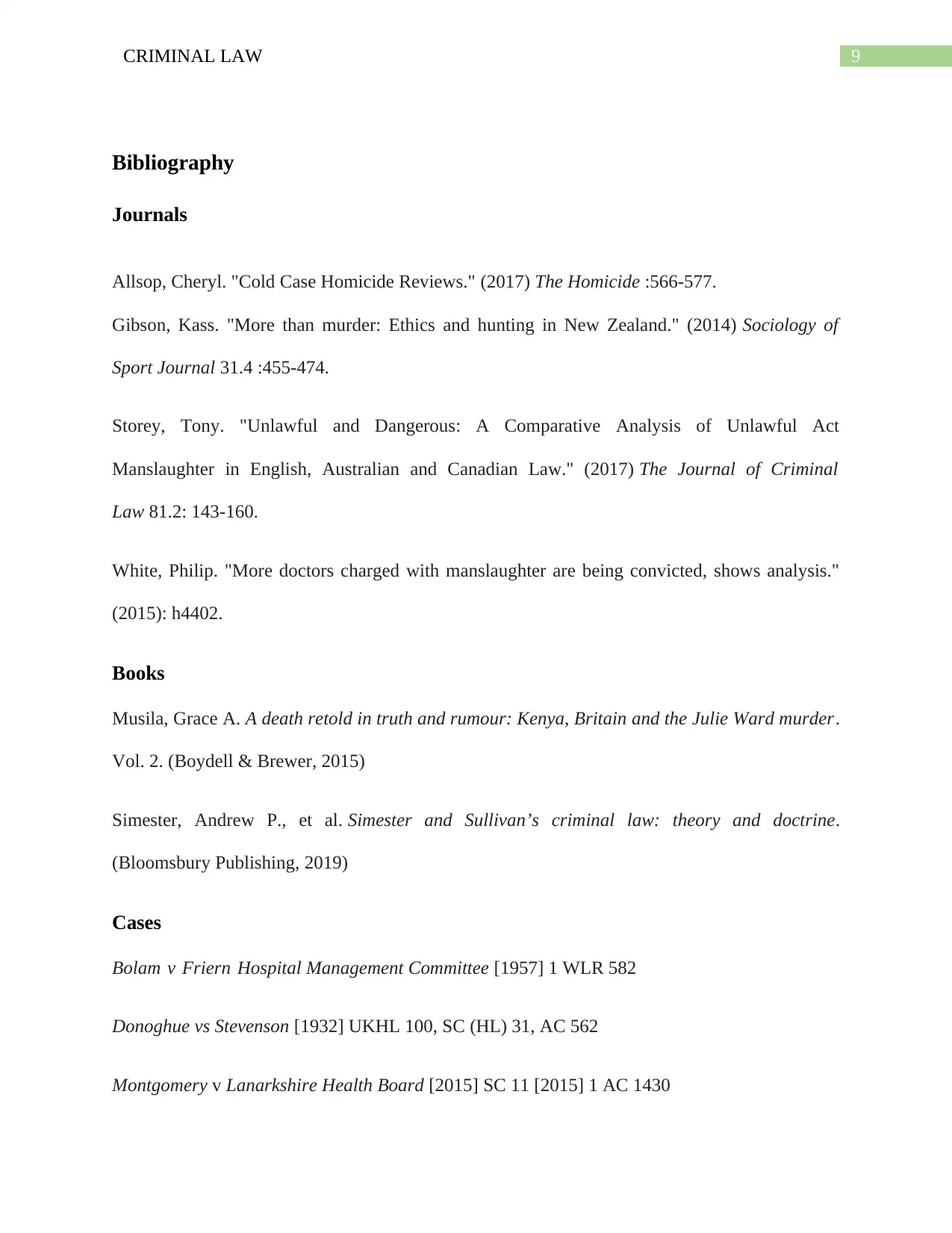
9CRIMINAL LAW
Bibliography
Journals
Allsop, Cheryl. "Cold Case Homicide Reviews." (2017) The Homicide :566-577.
Gibson, Kass. "More than murder: Ethics and hunting in New Zealand." (2014) Sociology of
Sport Journal 31.4 :455-474.
Storey, Tony. "Unlawful and Dangerous: A Comparative Analysis of Unlawful Act
Manslaughter in English, Australian and Canadian Law." (2017) The Journal of Criminal
Law 81.2: 143-160.
White, Philip. "More doctors charged with manslaughter are being convicted, shows analysis."
(2015): h4402.
Books
Musila, Grace A. A death retold in truth and rumour: Kenya, Britain and the Julie Ward murder.
Vol. 2. (Boydell & Brewer, 2015)
Simester, Andrew P., et al. Simester and Sullivan’s criminal law: theory and doctrine.
(Bloomsbury Publishing, 2019)
Cases
Bolam v Friern Hospital Management Committee [1957] 1 WLR 582
Donoghue vs Stevenson [1932] UKHL 100, SC (HL) 31, AC 562
Montgomery v Lanarkshire Health Board [2015] SC 11 [2015] 1 AC 1430
Bibliography
Journals
Allsop, Cheryl. "Cold Case Homicide Reviews." (2017) The Homicide :566-577.
Gibson, Kass. "More than murder: Ethics and hunting in New Zealand." (2014) Sociology of
Sport Journal 31.4 :455-474.
Storey, Tony. "Unlawful and Dangerous: A Comparative Analysis of Unlawful Act
Manslaughter in English, Australian and Canadian Law." (2017) The Journal of Criminal
Law 81.2: 143-160.
White, Philip. "More doctors charged with manslaughter are being convicted, shows analysis."
(2015): h4402.
Books
Musila, Grace A. A death retold in truth and rumour: Kenya, Britain and the Julie Ward murder.
Vol. 2. (Boydell & Brewer, 2015)
Simester, Andrew P., et al. Simester and Sullivan’s criminal law: theory and doctrine.
(Bloomsbury Publishing, 2019)
Cases
Bolam v Friern Hospital Management Committee [1957] 1 WLR 582
Donoghue vs Stevenson [1932] UKHL 100, SC (HL) 31, AC 562
Montgomery v Lanarkshire Health Board [2015] SC 11 [2015] 1 AC 1430
Secure Best Marks with AI Grader
Need help grading? Try our AI Grader for instant feedback on your assignments.
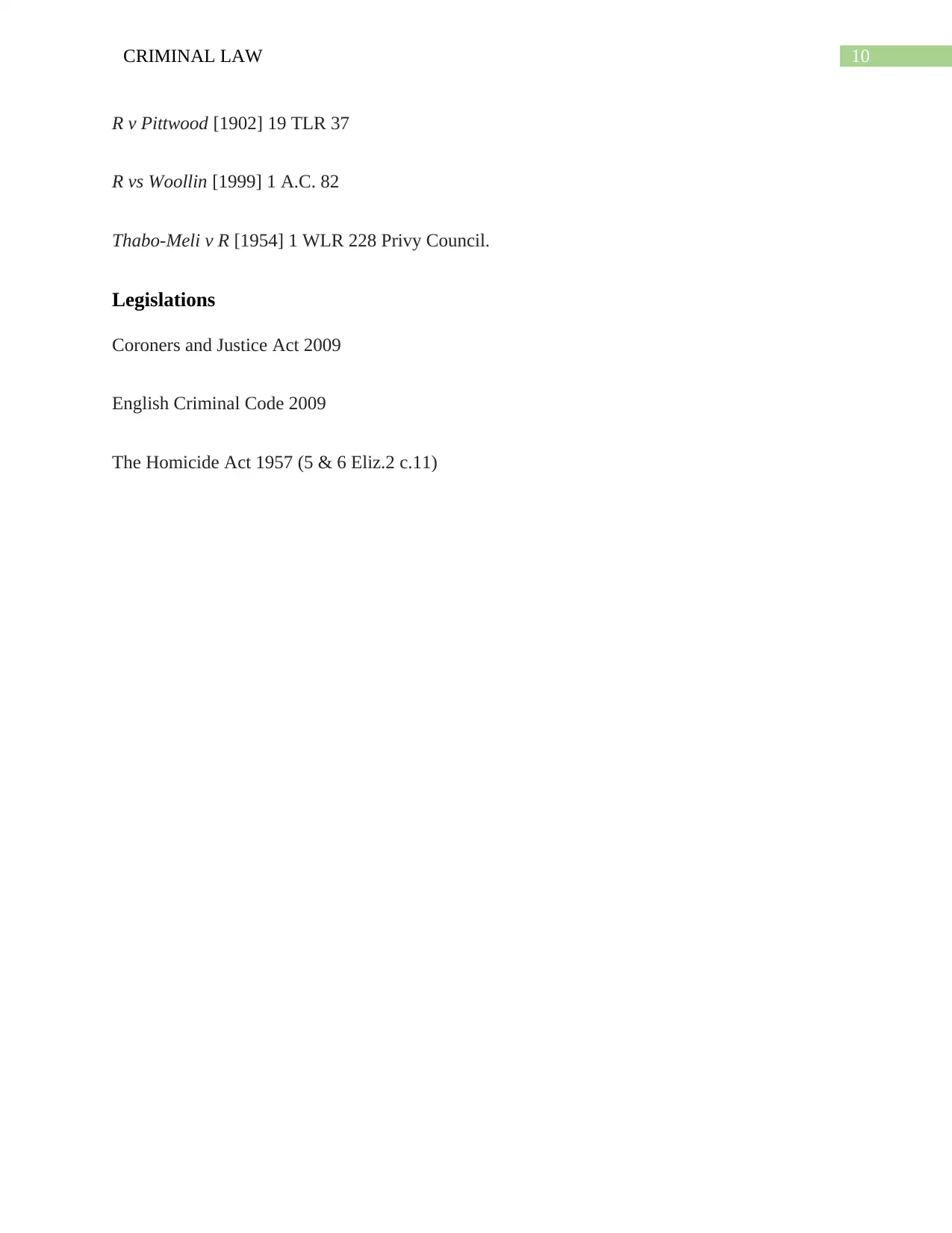
10CRIMINAL LAW
R v Pittwood [1902] 19 TLR 37
R vs Woollin [1999] 1 A.C. 82
Thabo-Meli v R [1954] 1 WLR 228 Privy Council.
Legislations
Coroners and Justice Act 2009
English Criminal Code 2009
The Homicide Act 1957 (5 & 6 Eliz.2 c.11)
R v Pittwood [1902] 19 TLR 37
R vs Woollin [1999] 1 A.C. 82
Thabo-Meli v R [1954] 1 WLR 228 Privy Council.
Legislations
Coroners and Justice Act 2009
English Criminal Code 2009
The Homicide Act 1957 (5 & 6 Eliz.2 c.11)
1 out of 11
Related Documents
Your All-in-One AI-Powered Toolkit for Academic Success.
+13062052269
info@desklib.com
Available 24*7 on WhatsApp / Email
![[object Object]](/_next/static/media/star-bottom.7253800d.svg)
Unlock your academic potential
© 2024 | Zucol Services PVT LTD | All rights reserved.





